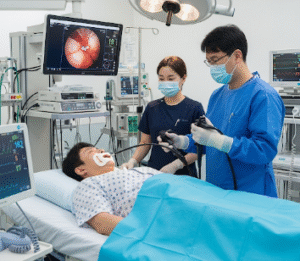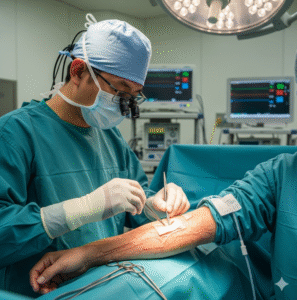What it is
Radiation therapy coordination refers to the planning, scheduling, and management of radiation treatments for patients with cancer, including gynecologic, breast, and other malignancies. Radiation therapy uses high-energy beams (X-rays, gamma rays, or proton beams) to kill or shrink cancer cells while minimizing harm to surrounding healthy tissue.
In Korea, radiation therapy coordination is conducted through multidisciplinary cancer care teams, ensuring seamless communication among radiation oncologists, medical oncologists, surgeons, radiologists, physicists, and nurses. The process includes diagnosis review, treatment planning, precise radiation delivery, and post-treatment follow-up.
➡️ Key aspects of radiation therapy coordination:
- Careful mapping of tumor location and treatment fields
- Integration with surgery and chemotherapy
- Regular monitoring to minimize side effects and adjust treatment
Why it’s done
Radiation therapy is a cornerstone in cancer treatment. Without proper coordination, patients risk delayed care, unnecessary side effects, or inconsistent treatment outcomes.
✔️ Medical reasons for radiation therapy coordination include:
- Definitive treatment: Radiation alone can cure some early-stage cancers
- Adjuvant therapy: To kill residual cancer cells after surgery
- Concurrent therapy: Combined with chemotherapy for more aggressive cancers
- Palliative therapy: To relieve pain and improve quality of life in advanced cancer
✔️ Benefits of coordinated radiation therapy:
- Accurate tumor targeting with minimal damage to healthy organs
- Smooth scheduling to avoid treatment delays
- Personalized dosing to maximize effectiveness and reduce toxicity
- Emotional support and counseling integrated into care
Alternatives
While radiation therapy is widely used, other treatments may serve as alternatives or complementary approaches depending on cancer type and stage.
🔹 Surgery:
- Preferred for some localized cancers, with or without adjuvant radiation
🔹 Chemotherapy:
- Used alone or in combination with radiation for systemic disease
🔹 Targeted therapy and immunotherapy:
- Modern treatments that attack cancer cells specifically, sometimes replacing radiation in select cases
🔹 Observation or palliative care:
- For patients unable to undergo radiation due to age, comorbidities, or advanced disease
Preparation
Preparation for radiation therapy coordination ensures safety and accuracy.
➡️ Medical preparation:
- Imaging tests (CT, MRI, PET scans) for precise tumor mapping
- Blood work to assess overall health
- Dental exams (for head/neck cancers) or gynecological evaluations (for pelvic cancers)
➡️ Personal preparation:
- Marking of treatment area with small tattoos or skin markers
- Arranging transportation for daily sessions (often 5 days per week for weeks)
- Preparing comfortable clothing and planning for possible fatigue
➡️ Mental preparation:
- Counseling to explain the treatment process and expected side effects
- Support groups and patient education sessions
- Emotional readiness for long-term treatment schedules
How it’s done
Radiation therapy coordination in Korea follows a systematic, technology-driven process.
✔️ Step 1 – Simulation and planning
- Patients undergo a CT simulation scan in treatment position
- Immobilization devices (molds, cushions) used for accuracy
- Radiation oncologists, physicists, and dosimetrists design a treatment plan using 3D imaging
✔️ Step 2 – Treatment delivery
- Treatments typically given daily, Monday to Friday
- Machines like linear accelerators deliver external beam radiation
- In gynecologic cancers, brachytherapy (internal radiation) may be used with radioactive sources placed inside the vagina or uterus
✔️ Step 3 – Monitoring
- Weekly checkups with oncologists during treatment
- Imaging (cone-beam CT) used before sessions to confirm accuracy
- Side effects managed promptly with supportive care
✔️ Step 4 – Follow-up
- After completing therapy, patients monitored regularly for recurrence
- Support services (nutrition, physiotherapy, counseling) provided
✔️ Duration:
- Sessions last 15–30 minutes each, over 3–8 weeks depending on cancer type
- Brachytherapy may require fewer but more intensive sessions
Recovery
Recovery from radiation therapy varies, but structured coordination helps patients cope effectively.
➡️ Immediate recovery:
- Fatigue, skin irritation, or mild nausea common
- For pelvic cancers, bowel or bladder irritation may occur
➡️ Physical recovery:
- Most acute side effects resolve within weeks after treatment
- Long-term side effects (fibrosis, dryness, organ changes) minimized with modern Korean techniques like IMRT (Intensity-Modulated Radiation Therapy) or proton therapy
➡️ Emotional recovery:
- Relief at completing treatment often mixed with fear of recurrence
- Counseling and support groups help patients adjust emotionally
- Survivorship programs focus on rebuilding strength and confidence
➡️ Key recommendations:
- Maintain hydration and balanced nutrition during recovery
- Gentle exercise like walking or yoga to reduce fatigue
- Attend all follow-up visits for recurrence monitoring
- Report any long-term side effects promptly
Treatment option in Korea
Korea is a global leader in radiation oncology, combining precision technology with holistic patient care.
✔️ Hospital facilities:
- Equipped with state-of-the-art technologies: IMRT, IGRT (Image-Guided Radiation Therapy), SBRT (Stereotactic Body Radiation Therapy), and proton therapy
- Specialized brachytherapy units for gynecologic cancers
- Comfortable, patient-centered radiation suites
✔️ Medical expertise:
- Radiation oncologists trained in advanced 3D and robotic-guided therapies
- Multidisciplinary tumor boards coordinate surgery, chemo, and radiation
- High success rates due to tailored treatment approaches
✔️ Post-treatment care:
- Survivorship clinics offering long-term follow-up
- Integrated rehabilitation, nutrition, and psychosocial care
- Support for intimacy, fertility preservation, and emotional well-being
✔️ Cultural aspect:
- Korean healthcare emphasizes precision, dignity, and holistic recovery
- Patients supported by family-centered care and rehabilitation centers similar to Sanhujoriwon, adapted for cancer recovery
➡️ Highlight: Radiation therapy coordination in Korea offers cutting-edge technology, expert multidisciplinary planning, and holistic recovery programs, ensuring patients receive world-class cancer treatment with minimal side effects and maximum quality of life.













